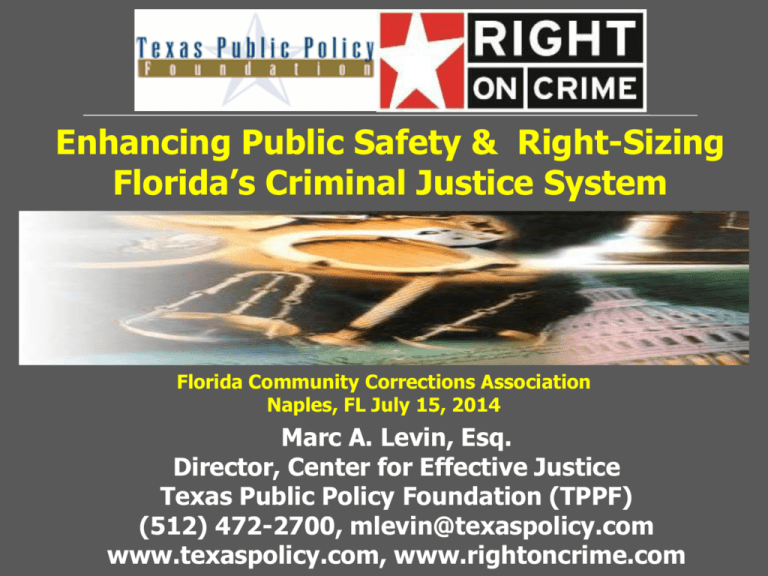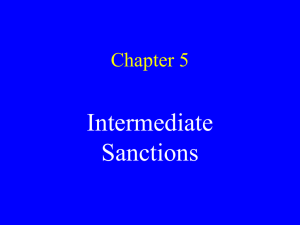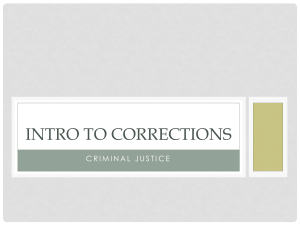to view the Powerpoint on improving Florida's
advertisement

Enhancing Public Safety & Right-Sizing Florida’s Criminal Justice System Florida Community Corrections Association Naples, FL July 15, 2014 Marc A. Levin, Esq. Director, Center for Effective Justice Texas Public Policy Foundation (TPPF) (512) 472-2700, mlevin@texaspolicy.com www.texaspolicy.com, www.rightoncrime.com TPPF Mission: Individual Responsibility, Free Enterprise, Limited Government, Private Property Rights We apply these foundational principles to criminal justice, bringing together stakeholders and working with policymakers and allies across the spectrum. Fiscal and tax restraint Civil justice reform (worked to enact loser pays in 2011) Center for Tenth Amendment Studies Deregulation of (over)regulated industries like insurance and utilities. Center for Effective Justice launched in March 2005, Right on Crime in Dec. 2010 Former Governor Jeb Bush, Speaker Newt Gingrich, Former Drug Czar Bill Bennett, Grover Norquist, and Other Conservative Leaders Endorse Right on Crime Statement of Principles Statement Supports Reining in Growth of Non-Traditional Criminal Laws, Cost-Effective Alternatives for Nonviolent Offenders, Emphasis on Restitution and Treatment, and Performance Measures. Favorably covered in numerous outlets such as: Gov. Reagan in 1971: “Our rehabilitation policies and improved parole system are attracting nationwide attention. Fewer parolees are being returned to prison than at any time in our history, and our prison population is lower than at any time since 1963.” LA.: Gov. Jindal: “hammer away at dubious distinction of highest incarceration rate in the world” with day reporting, jail reentry & work release TX.: Gov. Perry: “rehabilitate nonviolent offenders, spend less locking them up again” Govs. Kasich, Daugaard, Deal & Corbett preside over successful reforms. Gov. Bobby Jindal Is it always necessary to increase incarceration in order to reduce crime? State Incarceration Rate Change 2000-2007 Crime Rate Change 20002007 California 0% -16% Florida +16% -11% New York -16% -25% Texas -6% -8% Violent crime in New York City down 64% from 2000 to 2007 while 42% fewer inmates Capacity in programs that offer less costly alternatives to incarceration was expanded and then maintained in subsequent sessions, despite overall budget shortfalls in 2009 and 2011. Parole rate has increased, as Board finds that as more inmates are receiving treatment, more are safe to be released with supervision and fewer parolees committing new crimes. In 2005, additional $55 million in funding for stronger probation supervision to probation departments that adopted progressive sanctions. Participating probation departments reduced their technical revocations by 16% while those that didn’t increased technical revocations 8%. Had all departments increased their revocations by 8%, another 2,640 revocations for an average of 2.5 years at a cost to taxpayers of $119 million, not including prison construction. Texas probation revocation rate declined from 16.4% in 2005 to 14.7% in 2010. From 2007 to 2010, 1,306 fewer parolees allegedly committed an offense and 825 fewer were revoked for rule violations, saving $30.1 million. Parole supervision has added instant drug testing, more substance abuse treatment, more job placement resources, enhanced use of graduated sanctions; restored parole chaplains, and increased officers’ emphasis on helping parolees succeed instead of “trail’em, nail’em, and jail’em.” Lawmakers gave counties $58 million to keep youth misdemeanants once sent to state lockups. A 2009 budget provision allows counties that agree to reduce commitments to state lockups to receive a share of the state’s savings for local programs with performance measures. Juvenile incarceration down two-thirds and juvenile arrests are at record lows. Year 2005 FBI Index Crime Rate 4,857.1 Incarceration Rate Per 100k 681 2012 3,770.4 601 Percent Change -22.4% -11.7% Texas’ crime rate has reached its lowest level since 1968. Sources: Bureau of Justice Statistics and Texas Law Enforcement Agency Uniform Crime Reports HB 99/SB 360 adjusts penalties for Oxycodone and hydrocodone (thus restoring judicial discretion in hydrocodone/Oxycodone cases involving weights below 14 grams), and recalibrates sentences for trafficking. HB 89/SB 448, the “Threatened Use of Force Act” provides criminal immunity for the threatened use of force in circumstances where the actual use of force would have been justified and allows departure from mandatory minimum sentences in certain aggravated assault cases. HB 53/SB274 ensures that every inmate leaving prison will receive a photo ID at no cost to them. HB173 attached to SB850 ensures that DJJ youths have an individual education plan and access to technical training leading to vocational credentials or industry certification. The legislation also provides for online courses. HB7055 rewrites juvenile code to codify emphasis on prevention, bolster provider performance measures, and enhance transition services for youths leaving facilities. HB7035 seeks to bring Florida into compliance with Supreme Court rulings on life without parole for juveniles providing a single sentence review youth convicted of murder and two sentence reviews to all youth convicted of a nonhomicide crime, with initial review occurring after 15-25 years depending on the offense. HB 47/SB 194 passed in 2014 creates a mandatory minimum prison sentence for the illegal harvest of “spiny lobster.” The bill criminalizes “possession of spiny lobster during the closed season,” and “while on the water . . . possession of spiny lobster tails that have been wrung or separated from the body.” One year mandatory minimum only for 4th violation, but why not let judges use discretion? SB 328 would have allowed a downward departure from an otherwise applicable threeyear mandatory minimum for “trafficking” in drugs, applying only to defendants who 1) had not been previously convicted of selling of “trafficking” in illegal drugs; 2) possessed the relevant drugs without intent to sell them; 3) did not use a minor to obtain the drugs; 4) did not possess or threaten to use a firearm; and 5) were “amenable to substance abuse treatment. HB 247 would have made mandatory minimum sentences for the lowest-level drug “trafficking” offenses applicable only upon a second or subsequent conviction HB 1301/HB 967/SB 432 and HB103/SB112 would have allowed for departures form the 10-20-Life sentences in certain limited circumstances. HB 637/SB 1504 would have created mandatory minimum of 30 months for aggravated animal cruelty. 100,791 projected to spike to 106,793 by mid-2017, at an additional cost of $58 million. 15% are drug offenders Florida spends more than $2.4 billion on corrections, with about 90% going to prisons. Florida ‘s average time served grew 166% from 1990 to 2009, adding $1.4 billion in annual costs. Average time for drug offenders up 193%. Pew conducted dynamic risk analysis and found 14% of Florida nonviolent offenders released in 2004 could have served between 3 and 24 months less with no detriment to public safety. Would have reduced prison population by 2,640. Lowest youth arrest rate in 30 years Florida Redirection has been a national model, achieving a recidivism rate 46% less than commitment to youth lockup. 2009 state review found Redirection had saved or avoided some $41 million in costs. Florida’s Community-Based Intervention Services Model for reentry achieves rate of 76 to 92% of desistance in year after release. National pioneer in civil citation 47% of beds filled with low and moderate risk kids ,such as misdemeanants and probation violators. About 135 empty beds, half of start of 2014. Residential recidivism rate 41% after 1 year. Last year, 1,535 youths sent into adult system, yet national research shows comparable youths entering adult system 33% more than those kept in juvenile system and much higher rates of abuse. Gives counties the option to receive some state funds now spent incarcerating non-violent offenders in exchange for setting a prison commitment target and reducing recidivism. Funds could be used for treatment, stronger probation, electronic monitoring, prevention, problem-solving policing, and victim mediation and services. 2008-09: CA., IL. & AZ. pass performance-based probation funding measures providing departments with incentive funding for fewer commitments, fewer new crimes, and more restitution. AZ. measure led to 31% decline in new crimes and 28% drop in revocations. IL. bill requires system-wide use of assessment instruments that match risk and needs to supervision strategies, tracking an offender from entry to reentry. Drug courts: 34% lower recidivism: should focus on high-risk offenders who would have gone to prison. Hawaii HOPE Court with regular testing, treatment as needed, and weekend jail in few cases of non-compliance: 2/3 less reoffending, costs a third of drug court. Mental health courts: Amer. Journal of Psychiatry: less total & violent re-offending Bolster graduated sanctions and incentives Enhance use of risk/needs assessments to match offenders with programs FL. Study: GPS monitored probationers were 89% less likely to be revoked Georgia telephone reporting for low-risk offenders allows officers to spend more time visiting high-risk offenders Often targeted at probationers who need more structure as alternative to initial incarceration or used as parole condition. Union County, PA. center has 10.2% recidivism rate, Orange County, FL. has 82% success rate. Elements may include work, treatment as needed, literacy and other instruction, job placement, meeting restitution obligations, contribution to daily cost as able, drug testing. N.C.: Day reporting centers cost $15 a day Day Reporting Center, Dover, DE Rick Thomas installs hardwood floors in an Athens apartment complex as part of his construction job. Thomas graduated from the Day Reporting Center opened in 2008 by the Department of Corrections. Newly released offenders with a history of a substance abuse and cognitive challenges receive counseling and supervision. To graduate, participants must hold and maintain a job for 90 days. Georgia has 11 day reporting centers. Make second-time, low-level marijuana possession a jailable misdemeanor, not felony Require probation, treatment, and drug court in low-level possession cases in lieu of prison unless the offender has a prior substantial record and judge finds danger to public safety. S.C., KY., OH., GA., and AR. have reduced low-level drug possession penalties. Adjust property thresholds for inflation. 2014 Pew study: 64% of Florida inmates released without supervision (21,000 in 2012), the highest number in the nation. Pew 2013 New Jersey study found similar inmates put on parole had 36% fewer new offenses than max-outs. Promotes continuity of care for mentally ill. Use some savings from reduced time served to expand post-release supervision Florida Dept. of Corrections data shows 72% of returning inmates need substance abuse treatment in three years, 22% of them ever receive it, and 7% drop in reincarceration for those that do. Transition inmates nearing end of term to reentry settings closer to home. Halfway house study in Ohio found reduced reoffending for parolees and residents generate $6.7 million in earnings. Cost is less than half of prison. Norwich, CT. Halfway House Stop the Revolving Door Employed offenders on supervision twice as successful In-prison vocational training = 9% less re-offending Grant occupational licenses when offense is unrelated to the job. In some states, drug possession disqualifies a prospective barber. 2009 TX. law and ALEC model bill allow many ex-offenders to obtain a provisional license for most trades, which becomes permanent if they comply with law and rules. Provide protection to employers hiring ex-offenders from negligent hiring lawsuits – model Minnesota language says if no additional risk from job than simply being in society, no liability. Enable nonviolent, non-chronic exoffenders after time of compliance to obtain non-disclosure of record. States such as Georgia, Texas, and Ohio have recently adopted or expanded earned time for lower –level offenders. ALEC model legislation establishes earned time for community supervision. Studies of policies in New York, Wisconsin, and Washington find reduced recidivism as offenders have positive incentive to complete rehabilitative programs. Nationally, restitution ordered in only 26% of property cases – a third collected. Making Victims Whole Probationers pay $391 million in restitution (at least 34 times more per offender than inmates) and do 135 million service hours. Victim mediation: 14 states with statutes. Must be chosen by victim & offender. Proven to increase victim satisfaction as a result of apology and completion of restitution in 89% of cases. Most studies find less re-offending as well. Survey of Iowa Burglary Victims Sanction Percent Requesting Restitution Community Service Pay Fine Regular Probation Treatment/Rehabilitation Intensive Probation Short Jail Term Boot Camp Work Release Facility Prison Sentence > Year 81.4% 75.7% 74.3% 68.6% 53.5% 43.7% 41.4% 40.0% 34.3% 7.1% 1997 Iowa Crime Victimization Survey, University of Northern Iowa. Aligning Policies with Research Shift more youths and funds into community-based programs and close unused secure beds. Juvenile code rewrite advances this goal. Narrow grounds for transferring youths into adult system to most serious cases where offender has failed in juvenile system. Expand number of counties with diversion program and JDAI Of the 83 environmental criminal offenses in Florida, 52 are strict criminal liability offenses. More than 5,000 different offenses scattered throughout Florida’s codes. Offenses include mislabeling an artifact, using more than one net device from a bridge, and detaching a seed label. Identify unnecessary criminal laws and establish a default mens rea provision. 20 states have such a provision and ALEC model legislation offers blueprint. Which criminal laws are overlapping, obsolete, overbroad or vague, or lacking a mens rea provision? What percent of offenders in community corrections and prison are paying the restitution they owe? Which treatment, education, and work programs most reduce re-offending for each type of offender? How many low-risk offenders are going to prison? How many probationers and parolees are revoked for rule violations who could be safely supervised and treated given sufficient resources? Texas Public Policy Foundation www.texaspolicy.com Heritage Foundation www.overcriminalized.com Right on Crime www.rightoncrime.com Pew Public Safety Performance Project www.pewcenteronthestates.org Council of State Governments www.csgjusticecenter.org Justice Fellowship www.justicefellowship.org







